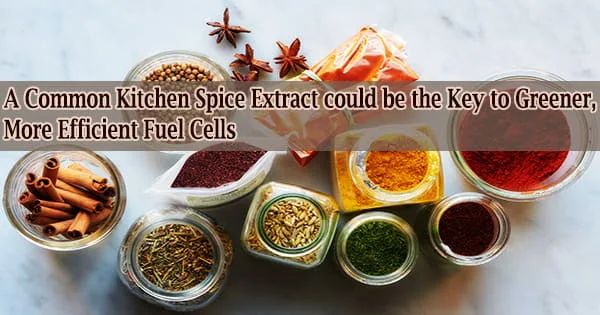Turmeric, a common household spice, contains an extract that could lead to more efficient and safer fuel cells.
Researchers from the Clemson Nanomaterials Institute (CNI) and the Sri Sathya Sai Institute of Higher Learning (SSSIHL) in India developed a new way to combine curcumin, a substance found in turmeric, and gold nanoparticles to create an electrode that converts ethanol into electricity with 100 times less energy.
While more testing is required, the discovery takes the possibility of replacing hydrogen as a fuel cell feedstock one step closer.
“Of all the catalysts for alcohol oxidation in alkaline medium, the one we prepared is the best so far,” said Apparao Rao, CNI’s founding director and the R. A. Bowen Professor of Physics in the College of Science’s.
Instead of burning, fuel cells produce electricity through a chemical reaction. Vehicles, buildings, portable electronic devices, and backup power systems all use them.
Hydrogen fuel cells are incredibly efficient and emit no greenhouse gases. Although hydrogen is the most abundant chemical element in the universe, it must be obtained from natural gas and fossil fuels because it only occurs naturally on Earth in compound form with other elements in liquids, gases, and solids. The extraction process adds to the expense and environmental effect of hydrogen fuel cells.
Furthermore, hydrogen used in fuel cells is a compressed gas, posing storage and transportation issues. Because it is a liquid, ethanol, alcohol generated from corn or other agricultural-based feeds, is safer and easier to carry than hydrogen.
There’s a big push in the industry for alcohol oxidation. This discovery is an excellent enabler for that. The next step is to scale the process up and work with an industrial collaborator who can actually make the fuel cells and build stacks of fuel cells for the real application.
Apparao Rao
“To make it a commercial product where we can fill our tanks with ethanol, the electrodes have to be highly efficient,” said Lakshman Ventrapragada, a former student of Rao’s who worked as a research assistant at the CNI and is an alumnus of SSSIHL.
“At the same time, we don’t want very expensive electrodes or synthetic polymeric substrates that are not eco-friendly because that defeats the whole purpose. We wanted to look at something green for the fuel cell generation process and making the fuel cell itself.”
The researchers concentrated on the anode of the fuel cell, which is where the ethanol or other feedstock gets oxidized.
Platinum is commonly used as a catalyst in fuel cells. However, platinum is poisoned by chemical intermediates like carbon monoxide, according to Ventrapragada. It’s also pricey.
Gold was used as a catalyst by the researchers. Curcumin was utilized instead of conducting polymers, metal-organic frameworks, or other complicated materials to deposit gold on the electrode’s surface because of its structural distinctiveness.
Curcumin is used to adorn gold nanoparticles and establish a porous network around them in order to stabilize them. Researchers used a 100-fold lower electric current to deposit the curcumin gold nanoparticle on the electrode’s surface than in earlier research.
The gold nanoparticles agglomerate without the curcumin covering, reducing the surface area exposed to the chemical reaction, according to Ventrapragada.
“Without this curcumin coating, the performance is poor,” Rao said. “We need this coating to stabilize and create a porous environment around the nanoparticles, and then they do a super job with alcohol oxidation.”
“There’s a big push in the industry for alcohol oxidation. This discovery is an excellent enabler for that. The next step is to scale the process up and work with an industrial collaborator who can actually make the fuel cells and build stacks of fuel cells for the real application,” he continued.
However, the study could have larger ramifications than just better fuel cells. According to Ventrapragada, the electrode’s unique features could lead to future applications in sensors, supercapacitors, and other fields.
Rao’s team is evaluating the electrode as a sensor for detecting changes in dopamine levels in partnership with the SSSIHL research team. Parkinson’s disease and attention deficit hyperactivity disorder have both been linked to dopamine.
When members of the study team evaluated urine samples from healthy volunteers, they were able to quantify dopamine to the acceptable therapeutic range using this electrode, which was a more cost-effective way than the current ones, Rao said.
“In the beginning stages of the project, we did not imagine other applications that gold-coated curcumin could support. However, before the end of the alcohol oxidation experiments, we were fairly confident that other applications are possible,” Ventrapragada said.
“Although we don’t have a complete understanding of what’s happening at the atomic level, we know for sure that curcumin is stabilizing the gold nanoparticles in a way that it can lend itself to other applications.”





